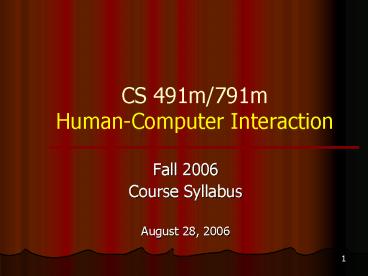CS 491m791m HumanComputer Interaction - PowerPoint PPT Presentation
1 / 21
Title:
CS 491m791m HumanComputer Interaction
Description:
http://www.id-book.com/ Recommended textbook's website (Schneiderman & Plaisant) ... Numerical-letter grade correspondence. A 90 -100 [maximum 100] A- 87 - 89 ... – PowerPoint PPT presentation
Number of Views:30
Avg rating:3.0/5.0
Title: CS 491m791m HumanComputer Interaction
1
CS 491m/791mHuman-Computer Interaction
- Fall 2006
- Course Syllabus
- August 28, 2006
2
Outline
- The Instructor
- The Students
- The Course
- The Texts
- Initial WWW Pointers
- Grading Scheme
- Policies
- Tentative Schedule
3
The Instructor.
- Sergiu Dascalu
- Room SEM-236
- Telephone 784-4613
- E-mail dascalus_at_cse.unr.edu
- Web-site www.cse.unr.edu/dascalus
- Office hours
- Tuesday 200 300 pm
- and Wednesday 530 630 pm
- or by appointment or chance
4
.The Instructor
- Sergiu Dascalu
- PhD, Dalhousie U., Halifax, NS, Canada, 2001
- Teaching and research at UNR,
- 2002-present (software engineering, HCI)
- Teaching and research at Dalhousie University,
1993-2001 (software engineering focus) - Teaching and research at the University
Politehnica Bucharest, Romania, 1984-1995 - (RT embedded systems focus)
- Consultant for software development companies in
Canada and Romania
5
The Students
- Registered
- 13 graduate students
- Prerequisite
- Instructors approval
6
The Course
- Classroom
- WRB 2023
- MW 230 - 345 pm
- Outline This course examines topics related to
designing computer systems that support people to
carry on their activities effectively and safely.
Topics covered include usability principles,
conceptual models, interface metaphors,
interaction paradigms and styles, task
description, task analysis, collaborative
technologies design, interaction design
processes, interface construction and
prototyping, evaluation techniques and
frameworks, user testing, and input-output
devices.
7
The Texts.
- Required textbook
- Jennifer Preece, Yvonne Rogers, and Helen
Sharps "Interaction Design Beyond
Human-Computer Interaction, Wiley Sons, 2002.
ISBN 0-471-49278-7 - Recommended textbook
- Ben Schneiderman, Catherine Plaisant, Designing
the User Interface Strategies for Effective
Human-Computer Interaction, 4th Edition,
Addison-Wesley, 2004 - ISBN 0-321-20058-6
8
.The Texts
- Lecture notes
- Presentations by the instructor
- Notes you take in the classroom
- Additional texts (see examples on slides 17-19)
- Material (papers, tutorials, etc.) that will be
indicated later by the instructor
9
Initial WWW Pointers
- Required textbooks website (Preece et als
Interaction Design) - http//www.id-book.com/
- Recommended textbooks website
- (Schneiderman Plaisant)
- http//wps.aw.com/aw_shneider_dtui_4/
- Gary Perlmans HCI bibliography
- http//hcibib.org/
10
Grading Scheme.
- Grading scheme for CS791m students (tentative)
- Assignments 20
- Presentations 15
- Midterm test 18
- Project paper 40
- Class participation 7
- TOTAL 100
11
.Grading Scheme
- Passing conditions (all must be met)
- 50 overall
- 50 in test
- 50 in project and paper
- 50 in assignments, presentations, and class
participation - For grade A at least 90 overall, at least 90
in class participation, and at least 60 in test - Note that there are no make-up tests or homework
in this course
12
Grading Scale
- Numerical-letter grade correspondence
- A 90 -100
maximum 100 - A- 87 - 89
- B 83 - 86
- B 78 - 82
- B- 75 - 77
- C 71 - 74
- C 66 - 70
- C- 63 - 65
- D 60 - 62
- D 55 - 59
- D- 50 - 54
- F lt 50
13
Policies
- Late submission policy
- Maximum 2 late days per assignment/project
deliverable - Each late day penalized with 10
- No subdivision of late days
- No late days for presentations and test
- Example a 90/100 worth assignment gets 81/100 if
one day late (900.9 81) or 72/100 if two days
late (900.8 72)
14
.Policies..
- Legal notices on the world-wide web Read and
comply with accompanying legal notices of
downloadable material - Specify references used
- Do not plagiarize (see next slide)
15
..Policies.
- Plagiarism and cheating Will not be tolerated.
Please read the policies of University of Nevada,
Reno regarding academic dishonesty - www.unr.edu/stsv/acdispol.html
16
Policies
- Disability Statement
- If you have a disability for which you will need
to request accommodations, please contact me or
someone at the Disability Resource Center
(Thompson Student Services - 107), as soon as
possible.
17
Additional Texts..
- Each student will deliver an assignment and
presentation based on additional reading texts
such as - 1 Don A. Norman, The Design Of Everyday Things
- 2 Don A. Norman, Emotional Design
- 3 Steven Krug, Dont Make Me Think A Common
Sense Approach to Web Usability - 4 Carolyn Snyder, Paper Prototyping The Fast and
Easy Way to Refine User Interfaces - 5 Mike Kuniavsky, Observing the User Experience
A Practitioner's Guide to User Research
18
.Additional Texts.
- 6 B.J. Fogg, Persuasive Technology Using
Computers to Change What We Think We Do - 7 Jef Raskin, The Humane Interface New
Directions for Designing Interactive Systems - 8 Ellen Isaacs and Alan Walendowski, Designing
from Both Sides of the Screen How Designers and
Engineers Can Collaborate to Build Cooperative
Technology - 9 Jeff Johnson, GUI Bloopers Donts and Dos for
Software Developers and Web Designers - 10 Karen Donahue, Built for Use Driving
Profitability - Through the User Experience
19
..Additional Texts
- 11 Joel Spolsky, User-Interface Design for
Programmers - 12 Ben Shneiderman, Leonardos Laptop
- 13 Jay David Bolter and Diane Gromala, Windows
and Mirrors Interaction Design, Digital Art,
and the Myth of Transparency - 14 Nathan Shedroff, Experience Design 1
- 15 Eric Begnan (editor), Information Appliances
and Beyond - 16 Malcolm McCullough, Digital Ground
Architecture, Pervasive Computing, and
Environmental Knowing
20
Tentative Schedule.
21
.Tentative Schedule































